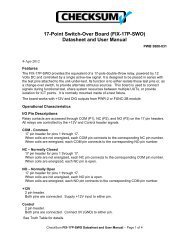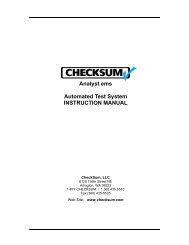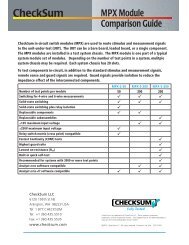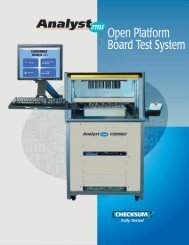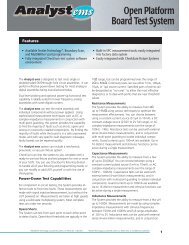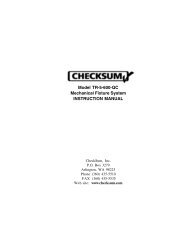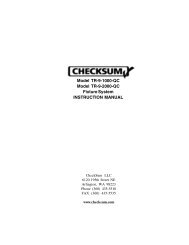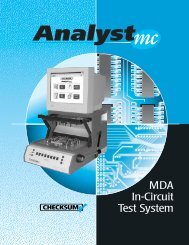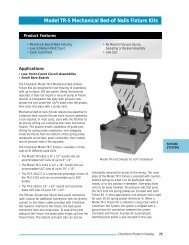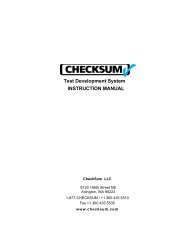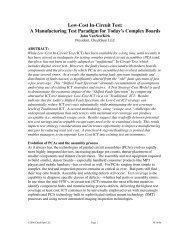CheckSum Corporate Backgrounder February 2005 Contact: Charla ...
CheckSum Corporate Backgrounder February 2005 Contact: Charla ...
CheckSum Corporate Backgrounder February 2005 Contact: Charla ...
Create successful ePaper yourself
Turn your PDF publications into a flip-book with our unique Google optimized e-Paper software.
<strong>CheckSum</strong>’s Philosophy<br />
1. In-circuit test is a mature technology. Though it is a critical technology for<br />
electronics manufacturing, few significant developments have occurred in the past<br />
decade.<br />
2. The fault spectrum has changed dramatically in the past 5 years. Component failure<br />
rates have declined dramatically, reducing the need for sophisticated digital backdrive<br />
technology.<br />
3. Loss of access and high-speed digital devices are limiting the coverage of ICT and<br />
forcing manufacturers to utilize AOI, AXI, and boundary scan technologies.<br />
4. Traditional in-circuit testers--designed to detect the typical fault spectrum of the<br />
1980’s--require very expensive fixtures, programs, and support, though their<br />
distinguishing technologies are not required for the typical boards of today.<br />
5. Low-cost in-circuit testers detect manufacturing defects and have operating costs of<br />
less than half those of traditional ICT. Also, low-cost systems can be acquired for<br />
1/10 th to 1/3 rd the price of traditional testers.<br />
6. Electronics manufacturers can justify the purchase of low-cost ICT for use on the<br />
80% of their boards that do not require traditional ICT solely based on the reduction<br />
in operating costs.<br />
7. Tester portfolio strategy, utilizing a combination of low-cost and traditional ICT,<br />
allows electronics manufacturers to ensure that each project is put on the appropriate<br />
tester while eliminating unnecessary costs associated with deploying technology that<br />
is not required by the job.<br />
8. North American electronics manufacturers are currently wasting over $250 million<br />
per year in unnecessary fixture, program, and support costs for traditional in-circuit<br />
testers that are being used when low-cost ICT would suffice.<br />
Management Team<br />
<strong>CheckSum</strong> is a growing, privately held company that is committed to the board test industry.<br />
In 2003, <strong>CheckSum</strong> was acquired from its founders by a group of private investors who saw<br />
the opportunity of expanding the role of low-cost ICT within the electronics manufacturing<br />
market. <strong>CheckSum</strong> represented a unique opportunity because it had developed the best lowcost<br />
ICT products and had primarily relied on word-of-mouth advertising, having grown<br />
steadily for 17 years without ever having a sales force. The investors found that <strong>CheckSum</strong>’s<br />
satisfied customer base was unique in the board test industry and are committed to expanding<br />
<strong>CheckSum</strong>’s presence by introducing <strong>CheckSum</strong>’s products to the numerous potential<br />
customers who may not know that there is a viable alternative to traditional “big iron” ICT.<br />
<strong>CheckSum</strong>’s owners looked at over 200 manufacturing companies before acquiring<br />
<strong>CheckSum</strong> in 2003. The ownership group consists of over a dozen business executives who<br />
lead and advise numerous successful private and public companies.<br />
John VanNewkirk, <strong>CheckSum</strong>’s President and CEO, believes that the time has come for<br />
economics to play a more significant role in the selection of in-circuit testers, as they have<br />
reached the mature phase of their development and the performance of low-cost ICT and<br />
high-cost ICT is identical for most boards.<br />
2



